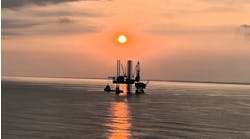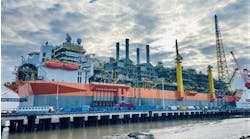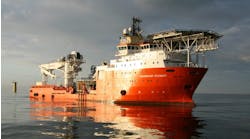Jeremy Beckman • London
Dutch developments back in vogue
Wintershall Noordzee has launched F16-E, the first new platform-based project in the Dutch sector for over a year. A flurry of developments may follow elsewhere, as some of the newer entrants advance production growth plans to take advantage of current oil and gas prices and potentially improved petroleum tax terms.
F16-E is based on results of an exploration campaign in blocks F16 and E18 in 2001. According to Wintershall's minority partner in the project, Dana Petroleum, a new steel platform will be installed with five development wells and a pipeline connecting to the NGT gas trunkline, which terminates in Uithuizen. Proven and probable reserves are estimated at 450 bcf. First gas is due out in January 2006 at a rate of around 150 MMcf/d. Wintershall has commissioned Subsea 7 to lay a new 10-in. OD 13% chrome line between its D12-A platform and Gaz de France's D15-FA-1 installation, where a new riser will be retrofitted.
null
A much larger development is in prospect on Petro-Canada's De Ruyter oilfield, where the operator is reportedly considering a scheme based on a steel platform mounted on a gravity-based structure. The company operates a similar installation on the Hanze oilfield, which it acquired following its takeover of Veba Oil & Gas' Dutch interests.
Dutch North Sea exploration is also picking up. Gaz de France, NAM, Total, and Wintershall all have jackups engaged for programs in the F, K, and L quadrants. And Total is thought to be lining up a well in the Waddenzee off northern Holland, which had been off limits to drillers since 1999 due to concerns over potential seabed subsidence. However, new studies suggest that gas – which was found in the area by NAM in the mid-1990s – could be produced safely through wells drilled from onshore locations. An advisory board has since recommended easing of restrictions on E&P activity.
The current upturn was likely influenced also by the government's decision to reconsider "depreciation at will." This measure, which had been introduced as a tax-break to encourage oil and gas investment, was suspended last year by the incoming Dutch administration. The impact was due to be assessed over a three-year period, but clearly, this was an experiment too far, given the worrying slump in local offshore activity.
The government will welcome one operator's support for its plan to re-inject CO2 into depleted gas fields to help reduce Dutch sector emissions. A similar proposal was recently rejected by operators on the UK shelf as being impractical and too costly, but Gaz de France (GdF) is considering a scheme for its K12 field. Gas produced from the K12-B platform contains substantial quantities of associated CO2, which is currently separated out and released to the atmosphere. However, a recent technical review suggested it would be relatively easy to re-inject the CO2 into the gas reservoir.
GdF has since agreed to participate in a three-phase feasibility study, which would involve building a small-scale test facility and developing a full-scale CO2 injection unit. Dutch geophysical institute TNO-NITG will model the predicted impact of injection on production activities, and present a report on the results of the demonstration project. More details available from Bert van de Meer, [email protected].
Subsea-shore for Atlantic/Cromarty
Amerada Hess and BG have been cleared to land gas from their Atlantic/Cromarty joint development at the SAGE terminal in eastern Scotland. The two-field project, said to involve the world's longest subsea tieback to shore, had been approved by the UK government in December. But implementation had been delayed pending sanction from SAGE operator Exxon to expand third-party processing capacity at the terminal. Kellogg Brown & Root, which completed front-end engineering for this program in January, is also charged with construction and installation of the equipment, which will include a new separation and compression plant. SAGE's main role is to handle supplies from ExxonMobil's Beryl complex in the Northern North Sea.
The terminal will also control operations on the two fields via a satellite link to Shell's new Goldeneye platform. This will be connected to Atlantic/Cromarty through a 32 km umbilical. Like Goldeneye, the fields lie in a previously undeveloped region of the Outer Moray Firth. Combined reserves are estimated at 224 bcf.
Two subsea wells will be drilled on Atlantic, tied back to a manifold, which will also receive production from Cromarty's single subsea completion, 12.5 km distant. The commingled wellstream will be piped to Goldeneye before heading to SAGE through a new 80-km, 16-in., wet gas trunkline to be laid by Allseas. The £205 million project should yield first gas early in 2006.
In the Central North Sea, CNR Internat-ional, the new operator of the Banff FPSO, has decided to re-inject some of this field's associated gas into the reservoir to lift oil recovery by up to 25 MMbbl, in turn extending field life by a further eight years. Three existing producer wells and two water injectors will be converted to four oil producers and one gas injector, thereby shifting the field's main drive mechanism from water injection to gravity drainage supported by gas injection. Reconfiguration work should be completed by this fall. CNR is also seeking government permission to lift oil production at its Murchison field in the northern sector by nearly 4,000 b/d, through a 6-km extended reach well from the platform into the Playfair accumulation.
Among other UK sector prospective developments, ExxonMobil is aiming for a two-three well scheme on its Arthur gas field in the southern sector, which would be gathered through a 30-km pipeline tied back to the Tullow-operated Thames platform. Talisman plans to develop its Tweedsmuir North and South discoveries through the Piper B platform, putting in up to 12 manifolded producer and water injector wells. And Venture Petroleum is looking at water injection for its Gadwall and Mallard satellites, both producing through the Kittiwake infrastructure.
Hamsun findings prompt re-think
Marathon looks to have proved up substantial new reserves within tieback reach of its proposed Alvheim multi-field development in the Norwegian North Sea. Well 24/9-7 on the Hamsun prospect, drilled 10-km south of the Alvheim cluster by the semi Deepsea Delta, encountered 12 m of net oil pay and 37 m of net gas pay, largely from two reservoirs. Three subsequent sidetracks were also productive. The results also confirmed reservoir communication between Hamsun and the Grieg oil discovery wells 24/9-6, drilled by Fina in 1994. Alvheim is the collective name for the Boa, Kameleon, Kameleon East, and Kneler fields.




